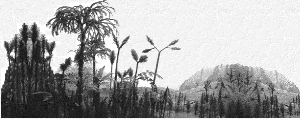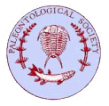

 |
|
 |
|
|
|
 |
International Organisation of Palaeobotany: The official homepage of the International Organisation of Palaeobotanists maintained by the palaeobotany group of the University of East London (UK) includes IOP Newsletters, PalaeoTalk, the searchable database Plant Fossil Record, IOP member information, Presentations and information on related links. |
 |
Paleobotanical Section of the Botanical Society of America. This homepage maintained by Chuck Daghlian (Dartmouth College, Hanover, NH) contains information on the section, publications, news about meetings and announcements, personalia and related links. |
 |
A Provisional World List of Geosites for Palaeozoic Palaeobotany by C.J. Cleal and B.A. Thomas (National Museum of Wales, Cardiff, UK) provides a inventory of the most important sites for Palaeozoic palaeobotany. This list was compiled for a new project initiated by the International Union of Geological Sciences (IUGS). |
 |
The homepage of the American Association of Stratigraphic Palynologists presents its Newsletter, information on publications, meetings, awards, a trading corner, a bulletin board, downloadable palynological data sets, a very useful e-mail and WWW-directory and links to related sites. |
 |
The Canadian Association of Palynologists presents its history, a summary of palynology in Canada with a directory of palynologists, highlights from newsletters, news about upcoming meetings and further links. |
 |
The International Federation of Palynological Societies is a federation of palynological societies all around the world. The IFPS publishes the newsletter Palynos. |
 |
The Review of Palaeobotany and Palynology is an international peer-reviewed journal on Palaeobotany and Palynology. This web site includes a table of contents starting in 1995 and further information about the journal. Recent papers are also available in PDF format. |
|
|
|
 |
The Illinois State Museum maintains a homepage about the famous Pennsylvanian (Upper Carboniferous) Mazon Creek fossils which includes a picture gallery of the common plants. |
 |
The University of California at Berkeley's Museum of Paleontology offers a number of pages on fossil plants. Especially recommended are the pages with short introductions to major groups of (fossil) plants. |
 |
The Emporia State University's Paleontological Museum in Emporia (KS) shows some Carboniferous plant fossils together with a display of the famous Hamilton Quarry. |
 |
The Paleobotany and Palynology Group of the Florida Museum of Natural History. This site in particular features a listing of all publications in which the museums specimens are figured or cited. This refers only to type and figured specimens. In some cases an illustration accompanies the referenced paper so that the user may see some of the exquisite material. Warmly recommended! |
 |
The home page of the Palaeobotany Section of the Senckenberg Natural History Museum and Research Institute in Frankfurt am Main (Germany) gives an overview of its past and current research activities illustrated with photographs of fossil plants. |
 |
The Homepage of the Geological Survey of Nordrhein-Westfalen in Krefeld. Look under Projects and go to Palynologie und Paläobotanik am GLA-NRW and see some nice fossil plants and learn more about palynology and current research projects. |
| The Nova Scotia Museum displays some of its best specimens on the web, including many plant fossils from this classical area. In addition there is also information about important sites, geology, fossil collectors etc. Have a look at the Pennsylvanian floras! | |
 |
Carboniferous fossils from the Piesberg near Osnabrück, Germany. These pages, presented by Jens-Wilhelm Janzen, show pictures - mostly of excellent quality - of a wide variety of plant fossils from the Upper Westphalian of the classical Piesberg locality. |
 |
Hans' Paleobotany Pages, maintained by Hans Steur, includes information and pictures on early land plants, the enigmatic plant Parka decipiens, arborescent lycopods and pteridosperms. |
 |
Monte and Harrison Hieb's Plant
Fossils of West Virginia shows a nice series of fossil plants, including
some truly spectacular specimens, from the Middle Pennsylvanian (= Upper
Carboniferous).
|
|
|
|
 |
Robert A. Gastaldo's course Paleobotany, includes taphonomic processes responsible for the generation of plant-bearing lithologies, hydrocarbon accumulating systems, biostratigraphic assemblages, paleoecological restorations of the Phanerozoic and evolution of major plant groups. |
| The Virtual Paleobotanical Laboratory by Nan Crystal Arens (University of California Berkeley), is a comprehensive treatment of the fossil record of land plants, is divided into 12 chapters, lab I through XII. Each lab has a title page, a page with questions around the group or subject of study, a list of literature and links for further reading and exploration, and a virtual gallery of images from the lab. The directory page is a generalized phylogeny that presents an overview hypothesis of relationships among the land plants. | |
 |
Oxford Plant Sciences / Palaeobotany Lectures by Robert A. Spicer (Earth Sciences Department, The Open University) offers several lectures. "Living off the Land" considers the evolution of both reproductive and vegetative features of land plants that enabled colonization of land and the evolution of early forest ecosystems by the end of the Devonian. "On the Beach" introduces the concept of geological time, the quality of the plant fossil record, and evidence for the earliest phases of the colonization of land by plants. |
 |
Plant Fossils and Evolution is a palaeobotany syllabus by Kathleen B. Pigg, Department of Plant Biology, Arizona State University. This course consists of 13 labs and a series of illustrations of fossil plants. |
 |
The Ginkgo tree, a unicum with a past. An online article by Prof. Dr. W. Jung for the special exhibit "Von der Evolution vergessen? - Lebende Fossilien" (Forgotten by the evolution - living fossils) of the Palaeontological Museum Munich (in German). |
|
|
|
| The PaleoNet Pages is a system of listservers, www pages, ftp sites, and a electronic journal designed to enhance electronic communication among palaeontologists maintained by the Museum of Paleontology, University of California Berkeley and the Natural History Museum in London. This link connects you with the London-based server. | |
 |
The Palaeontological Association homepage features information about the association, the Palaeontology Newsletter, news about meetings and publications, a list of palaeontologists' e-mail addresses and some useful palaeontological www- sites. |
 |
The Paleontological Society includes information on the society such as activities, publications and a list of links to other web sites. |
 |
The ETE Consortium is the homepage of the Evolution of Terrestrial Ecosystems Consortium which is primarily based at the National Museum of Natural History / Smithsonian Institution in Washington DC, The University of California at Santa Barbara and the University of Helsinki. |
 |
The 2nd edition of the Glossary of Pollen and Spore Terminology. This is the new web edition of the glossary by W. Punt, S. Blackmore, S. Nilsson and A. Le Thomas, which was the result of a project of the Working Group on Palynological Terminology, functioning under the auspices of the International Federation of Palynological Societies (IFPS). This 2nd revised www edition is presented by Peter Hoen from whom also a free printed copy of the printed 1st edition (1994) can be obtained. His address is: Laboratory of Palaeobotany and Palynology, Budapestlaan 4, NL-3584 CD Utrecht, The Netherlands. |
 |
Palaeontologica Electronica is a general palaeontological journal of the widest possible scope accesible on the worldwide web. It is envisaged to publish papers, editorials, book reviews, anouncements etc. from any branch of palaeontology, including palaeobotany and palynology. Unlike print-based journals, Palaeontologica Electronica is highly graphical in both format and content. The use of colour in figures and graphics is encouraged. The primary staff of the journal includes five editors and an international board of associate editors. |
|
|
|
| The Index Nominum Genericorum (Plantarum) (ING) is a large searchable database with generic names for all organisms covered by the International Code of Botanical Nomenclature. This index includes generic names of all extant and fossil plants and is an updated follow-up of the printed version and gives bibliographical citations and information about homonymy, typification and nomenclatural status of generic names. The Index Nominum Genericorum is a collaborative project of the International Association of Plant Taxonomy (IAPT) and the Smithsonian Institution. The ING is edited by Ellen R. Farr (Smithsonian, Washington DC) and Gea Zijlstra (University Utrecht). | |
| The Palynology Database created by the Canadian Museum of Nature is one of the largest databases on fossil and recent pollen and spores. It includes taxonomic, collection, geographic, preparation, and photographic information about 15,000 species of plants. | |
 |
The Royal Botanic Gardens, Kew (UK) maintain the IBS: Vascular Plant Families and Genera. This database is linked with the Fossil Record 2. |
 |
TreeBASE is a relational database of phylogenetic information. TreeBASE is a pilot project sponsored by the National Science Foundation, Harvard University Herbaria and the University of California, Davis. |
| Fossil Plants and Algae Types is a register of types of fossil plants and algae maintained by the National Museum of Natural History / Smithsonian Institution in Washington DC (gopher menu!). | |
 |
The Plant Fossil Record is a large searchable database maintained by the International Organisation of Palaeobotany. |
| The Fossil Record 2 Database presents the data of the Fossil Record 2 by M.J. Benton (1993, Chapman & Hall, London, 845 pp.). | |
| Catalogue of Palaeontological Types in Austrian Collections is a searchable database with 26,000 figured (and unfigured) specimens, including many types, from 10 Austrian collections. In addition 800 references are listed. This is a joint project of the Austrian Academy of Sciences, the Österreichische Nationalbank and the Naturhistorisches Museum in Vienna, coordinated by Dr. Johanna Kovar-Eder (Vienna). | |
|
|
|
 |
Links for Palaeobotanists by Klaus-Peter Kelber, Department of Mineralogy, University of Würzburg, presents a long list with links for palaeobotanists. This frequently - almost daily (!) - updated list is definitely the best start for a further search. Original contributions on Keuper (Triassic) floras will follow soon! |
| Scientific WWW Servers by the Department of Geological Sciences of Indiana University is an impressive listing of worldwide(!) web sites of government organisations, geological surveys, professional organisations, universities, lab safety, companies, software, online maps, publications, a virtual library and further internet resources. | |
 |
The Illinois State Geological Survey maintains a page with Paleontology Links which includes some palaeobotany links. |
| WWW Sites of the palynology group of the University of Arizona lists an impressive number of palynological links including institutions and personal homepages. | |
 |
Scott's Botanical Links on the homepage of the Botanical Society of America gives an exhaustive list of resources including palaeobotanical and palynological links and other useful sites for palaeobotanists and palynologists |
 |
The Internet Directory for Botany: Paleobotany, Palynology, Pollen being part of the Internet Directory for Botany also gives an excellent list of palaeobotanical and palynological websites |
| © Forschungsstelle für Paläobotanik, Westfälische Wilhelms-Universität Münster |
March 2000
|